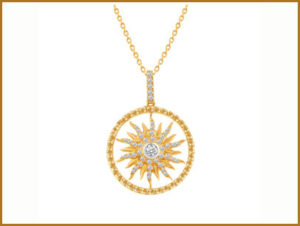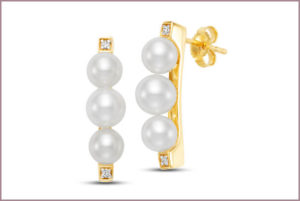2020 Signals Year of Uncertainty
Despite the distractions people will still buy jewelry if they’re given reasons to.
The retail industry is forecasting a cheerful holiday season, as consumers remain in a bullish mood driven by strong personal finances and near-term confidence in the overall economy, says Deloitte in its 2019 holiday retail survey.
The London-based financial advisory service underscores that the holiday season is no longer just the time to buy gifts, it’s also a time consumer spending overall gets a bump. But make no mistake, consumers while spending, remain price and product focused, and love a great holiday promotion. Deloitte finds that shoppers want quality products and variety, good deals and convenience.
 While the short-term consumer sentiment is positive, headwinds are forming, Deloitte signals. For the first time since 2012, fewer than 40 percent of consumers in its survey expect the economy to improve in 2020. This reflects a 13 percent decline from 2018.
While the short-term consumer sentiment is positive, headwinds are forming, Deloitte signals. For the first time since 2012, fewer than 40 percent of consumers in its survey expect the economy to improve in 2020. This reflects a 13 percent decline from 2018.
Matthew Shay, president and CEO of the National Retail Federation (NRF) sees uncertainty around issues including trade, interest rates, global risk factors, and political rhetoric. Consumers are in good financial shape, but he recognizes consumer confidence could be eroded by continued deterioration of these and other variables.
NRF Chief Economist Jack Kleinhenz describes the uncertain macroeconomic environment as having many moving parts and lots of distractions that make predictions for 2020 difficult to make. “There is significant economic unease, but current economic data and recent momentum of the economy show that we can expect a stronger holiday season than last year.”
According to the International Monetary Fund, next year’s recovery in the global economy will be slightly weaker than expected, and U.S. growth will continue to slow. The IMF trimmed its global growth forecast for 2020 by 0.1 percentage point to 3.4 percent, saying that rising trade and geopolitical tensions had put economies in a “precarious” position. It expects growth of 3 percent this year, the weakest expansion since the global financial crisis.
For 2020, IMF forecasts the U.S. economy will grow by 2.1 percent, considerably weaker than the 4 percent President Trump promised earlier in his presidency.
While the economy is relatively good and unemployment is low, not everyone has discretionary income to spend,  says Liz Chatelain, president of the jewelry consumer market research firm, MVI Marketing, with stagnant or low wages, high healthcare costs and real estate taxes among the realities.
says Liz Chatelain, president of the jewelry consumer market research firm, MVI Marketing, with stagnant or low wages, high healthcare costs and real estate taxes among the realities.
MVI research hears from two distinct groups, Chatelain says, those who say the economy is great and those who say they hear the economy’s great but don’t feel it. “The problem is that most people don’t save enough flexible cash.”
Andrea Hill, of the Chicago-based Hill Management Group says she’s watchful of a recession. “If we don’t come to some meaningful trade agreement with China, and soon, we could see a recession happen. The indicators are there for a recession in the next one to two years anyway, but I think continued trade stress with China could make it happen faster. And of course, there’s the election.”
Giving Reasons
Despite the distractions, Hill says that people will still buy jewelry if they’re given reasons to. In fact, one of her challenges to the industry is to present a unified, powerful, positive face of love, openness, and acceptance. “It’s not our usual ‘look’ as an industry, but it might be the thing that helps us transform in this new era. In a world where everyone is tearing at one another, people look for reasons to feel good. Jewelry is a reason to feel good.”
Hill believes that while there are challenges, the jewelry industry can rise above it if it continues to give people meaningful reasons to buy jewelry. “I don’t expect the CAGR of the industry to shrink in 2020,” she says. “That business will be going somewhere. I think those who get creative and positive will bring that business to themselves.”
Dana Cali for the New York pearl house, Mastoloni says there are many ways jewelers can positively impact the gift-shopping experience for their customers, including complementary gift-wrapping, personal messaging, and simple add-ons (i.e. jewelry cloth or cleaning, ring resizing, or pearl restring).
To deliver the best experiences for their customers, jewelers really need to know their business and focus on their best customers, underscores Cynthia Speight, marketing manager for IBGoodman, Newport, Kentucky.
 “Jewelry has incredible experiences to offer that are relevant to people who love jewelry and gems,” says Hill. As advocated in a recent Plumb Club webinar on female self-purchasers, Hill encourages jewelers to find the answers to how they can turn their jewelry store into an experience by asking these questions: What must you do to make it possible for your customers to pick up the jewelry, try it on, look in a mirror (without asking for one), and rapidly share on social media? How can you create integrations between smart phones and jewelry displays so a customer can scan a QR code and learn things about a designer, a collection, or a product that they couldn’t learn by just looking at it? How can you help customers experience your store through relational merchandising?
“Jewelry has incredible experiences to offer that are relevant to people who love jewelry and gems,” says Hill. As advocated in a recent Plumb Club webinar on female self-purchasers, Hill encourages jewelers to find the answers to how they can turn their jewelry store into an experience by asking these questions: What must you do to make it possible for your customers to pick up the jewelry, try it on, look in a mirror (without asking for one), and rapidly share on social media? How can you create integrations between smart phones and jewelry displays so a customer can scan a QR code and learn things about a designer, a collection, or a product that they couldn’t learn by just looking at it? How can you help customers experience your store through relational merchandising?










